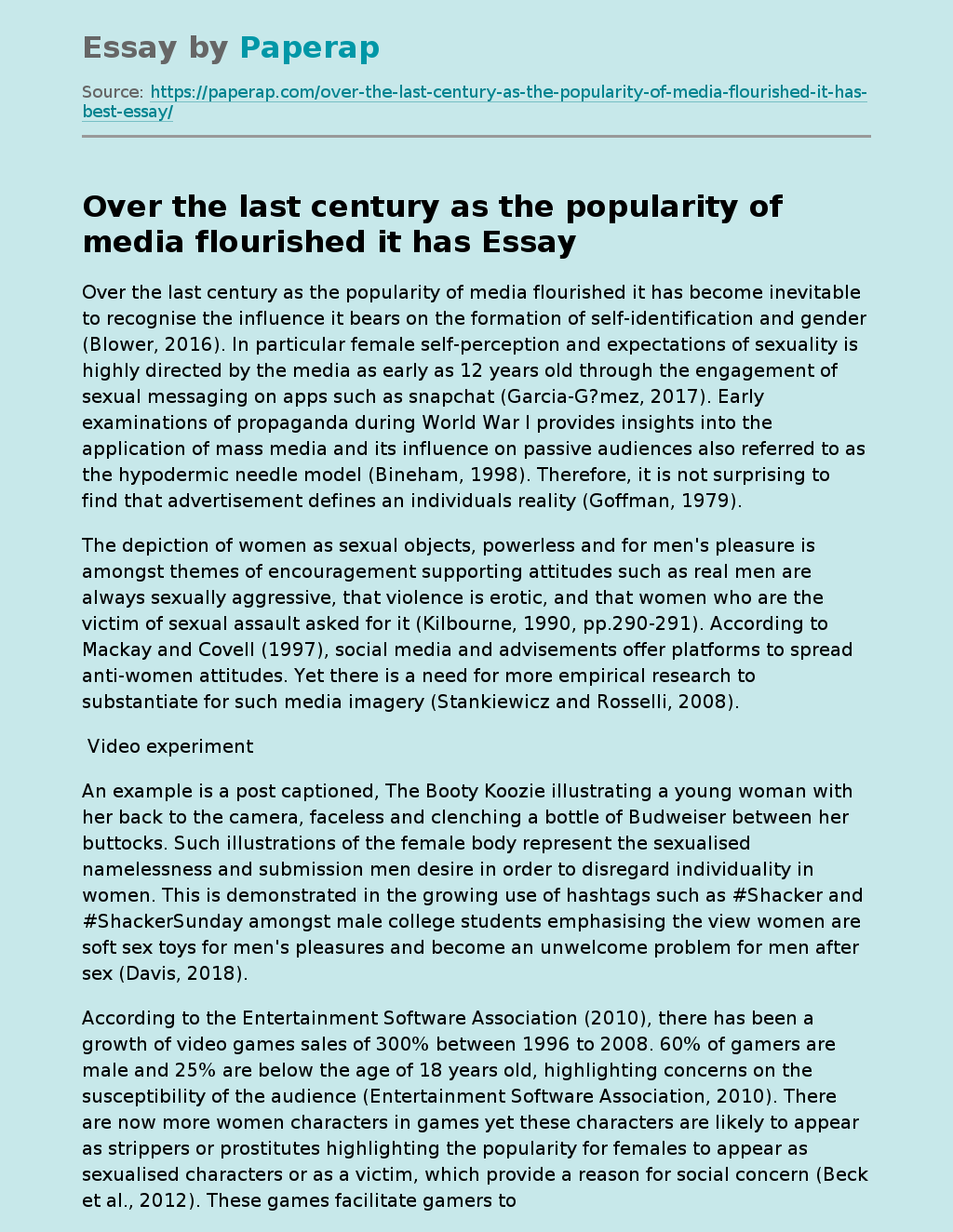Social Media and Violence
The following sample essay on “Social media and violence” raises the issue of social media regarding harassment and gender-based violence. In particular, depictions of women as sexual objects.
Over the last century as the popularity of media flourished it has become inevitable to recognise the influence it bears on the formation of self-identification and gender (Blower, 2016). In particular female self-perception and expectations of sexuality is highly directed by the media as early as 12 years old through the engagement of sexual messaging on apps such as snapchat (Garcia-Gmez, 2017).
Early examinations of propaganda during World War I provides insights into the application of mass media and its influence on passive audiences also referred to as the hypodermic needle model (Bineham, 1998). Therefore, it is not surprising to find that advertisement defines an individuals reality (Goffman, 1979).
The depiction of women as sexual objects, powerless and for men’s pleasure is amongst themes of encouragement supporting attitudes such as real men are always sexually aggressive, that violence is erotic, and that women who are the victim of sexual assault asked for i (Kilbourne, 1990, pp.
290-291). According to Mackay and Covell (1997), social media and advisements offer platforms to spread anti-women attitudes. Yet there is a need for more empirical research to substantiate for such media imagery (Stankiewicz and Rosselli, 2008).
An example is a post captioned, The Booty Koozie illustrating a young woman with her back to the camera, faceless and clenching a bottle of Budweiser between her buttocks. Such illustrations of the female body represent the sexualised namelessness and submission men desire in order to disregard individuality in women.
This is demonstrated in the growing use of hashtags such as #Shacker and #ShackerSunday amongst male college students emphasising the view women are soft sex toys for men’s pleasures and become an unwelcome problem for men after sex (Davis, 2018).
According to the Entertainment Software Association (2010), there has been a growth of video games sales of 300% between 1996 to 2008. 60% of gamers are male and 25% are below the age of 18 years old, highlighting concerns on the susceptibility of the audience (Entertainment Software Association, 2010). There are now more women characters in games yet these characters are likely to appear as strippers or prostitutes highlighting the popularity for females to appear as sexualised characters or as a victim, which provide a reason for social concern (Beck et al., 2012). These games facilitate gamers to virtually participate in violence against women, it is through this participation that gamers become desensitise to violence such as rape (Dill, 2009).
The definition of rape myths has been disputed amongst much creating inconsistency in the examination and application of such a concept (Lonsway and Fitzgerald, 1994). Burt (1980, pp. 217) defines rape myths as prejudicial, stereotyped, or false belief about, rape victims, and rapists. Social learning theories stress negative imagery of women of such in pornography and advisement holds a fundamental role in the acceptance of rape. Studies indicate sex offenders are 3 times more likely to possesses pornographic material than an average male, suggesting this is how men come to accept women as objects and view them as sexual playthings (Walsh and Ellis, 2007).
Social learning theory of rape emerged through theorising the work of Bandura (1972) suggesting that aggression is a learned behaviour through modelling which is strengthened by intermittent reinforcement. Social learning theory of rape is broken into 4 internal stages:
- preservation of rape myths such as women secretly desire being raped,
- modelling rape or violence against women witnessed in real life or mass media,
- association of sex and violence through repetitive reviewing,
- desensitisation of fear, pain and humiliation of sexual assault (Ellis, 1989).
Many video games have been banned due to concerns over violence as there is no limit to what degree gamers can engage in violent acts in the virtual world
Many video games have been banned due to concerns over the limitless of violence against women gamers can engage in a virtual world of gaming (Lah, 2010). An example is the game Rapelay with a set goal to rape women, yet internationally banned it still has a growing popularity and is still acceptable to many (Trip, 2010). Regardless there still exists a massive market for bestseller games such as Grand Theft Auto which depict women as a sexual object and provides a virtual space for gamers to emulate sexually violent acts. These sexually aggressive games and films are acknowledged to develop negative aptitudes against women (Liznz, Donnersteine and Penrod, 1988).
Social Media and Violence. (2019, Nov 25). Retrieved from https://paperap.com/over-the-last-century-as-the-popularity-of-media-flourished-it-has-best-essay/

